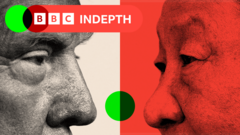As Trump returns to power, the dynamics of US-China relations are poised for dramatic shifts amid economic and geopolitical tensions.
Trump and Xi's Turbulent Relations: Can They Find Common Ground Again?

Trump and Xi's Turbulent Relations: Can They Find Common Ground Again?
Exploring the volatile relationship between Donald Trump and Xi Jinping as tensions rise ahead of his second presidential term.
In a park adjacent to Beijing's Temple of Heaven, retirees gather to exercise, embodying the phrase "health is wealth" while pondering the uncertain economic future that looms over them. With Donald Trump set to return to the presidency, sentiments about the imminent changes in US-China relations are mixed. The memories of his previous presidency, during which he famously remarked about his "love" for Xi Jinping, contrast with the harsh realities of a trade conflict that saw over $300 billion in tariffs placed on Chinese goods.
Despite some lighthearted memes about Trump circulating in Chinese social media, many citizens express anxiety about his unpredictable approach. “You just never know with him,” states a cautious retiree who admires Trump's bold image. Trump’s cabinet selections indicate a shift towards a tougher stance, with Marco Rubio describing China as “the threat that will define this century.”
Analysts believe that while China has prepared for Trump’s return, the relationship is likely to be tumultuous. Xi’s recent warnings against a "new cold war" illustrate the stakes involved, as the two nations grapple with an escalating rivalry that encompasses trade, security, and global influence. The strategic landscape has been altered significantly since Trump’s first term, when relations were marked by initial camaraderie soured by the pandemic and growing distrust.
The challenges are compounded by Xi Jinping's consolidated power and ambitions for China to regain its historical status as a preeminent global power, against a backdrop of economic sluggishness, youth unemployment, and territorial affirmations regarding Taiwan. Trump’s inclination towards tariffs, driven by his "America First" agenda, might exacerbate China's struggles, compelling it to diversify trade alliances away from the US.
Additionally, reports indicate China's commitment to enhancing its military capabilities. China's newly showcased stealth fighter jets and advancements in nuclear propulsion for a future aircraft carrier add to Washington's unease, especially as concerns grow regarding Beijing's assertiveness over Taiwan. Nonetheless, Trump appears to respect Xi's authoritative governance style, recognizing the delicate interplay between personal rapport and political maneuvers.
If the past is any indication, both leaders’ nationalist aspirations may lead to conflict as they grapple to assert dominance. Xi’s long-term outlook and the “golden age” vision for China could clash with Trump's economic policies, potentially marking a shift in not just bilateral relations, but global dynamics for decades to come. Many Chinese citizens hope for improvement and stability, but brace for the ramifications of a resurgent Trump administration. With the ability to influence alliances firmly in his grasp, Xi may find that time—and a more maneuverable geopolitical landscape—sits in his favor.
Despite some lighthearted memes about Trump circulating in Chinese social media, many citizens express anxiety about his unpredictable approach. “You just never know with him,” states a cautious retiree who admires Trump's bold image. Trump’s cabinet selections indicate a shift towards a tougher stance, with Marco Rubio describing China as “the threat that will define this century.”
Analysts believe that while China has prepared for Trump’s return, the relationship is likely to be tumultuous. Xi’s recent warnings against a "new cold war" illustrate the stakes involved, as the two nations grapple with an escalating rivalry that encompasses trade, security, and global influence. The strategic landscape has been altered significantly since Trump’s first term, when relations were marked by initial camaraderie soured by the pandemic and growing distrust.
The challenges are compounded by Xi Jinping's consolidated power and ambitions for China to regain its historical status as a preeminent global power, against a backdrop of economic sluggishness, youth unemployment, and territorial affirmations regarding Taiwan. Trump’s inclination towards tariffs, driven by his "America First" agenda, might exacerbate China's struggles, compelling it to diversify trade alliances away from the US.
Additionally, reports indicate China's commitment to enhancing its military capabilities. China's newly showcased stealth fighter jets and advancements in nuclear propulsion for a future aircraft carrier add to Washington's unease, especially as concerns grow regarding Beijing's assertiveness over Taiwan. Nonetheless, Trump appears to respect Xi's authoritative governance style, recognizing the delicate interplay between personal rapport and political maneuvers.
If the past is any indication, both leaders’ nationalist aspirations may lead to conflict as they grapple to assert dominance. Xi’s long-term outlook and the “golden age” vision for China could clash with Trump's economic policies, potentially marking a shift in not just bilateral relations, but global dynamics for decades to come. Many Chinese citizens hope for improvement and stability, but brace for the ramifications of a resurgent Trump administration. With the ability to influence alliances firmly in his grasp, Xi may find that time—and a more maneuverable geopolitical landscape—sits in his favor.




















